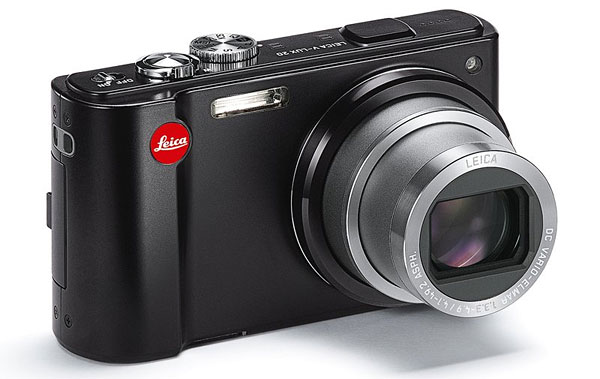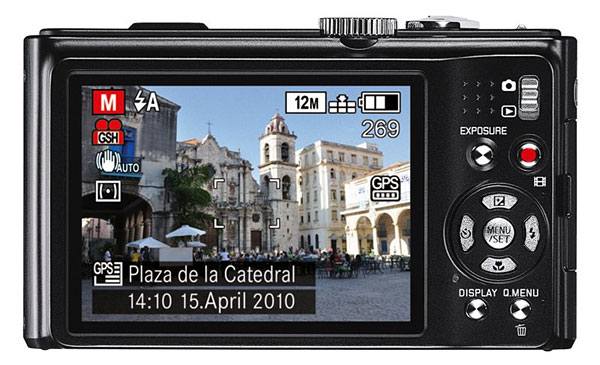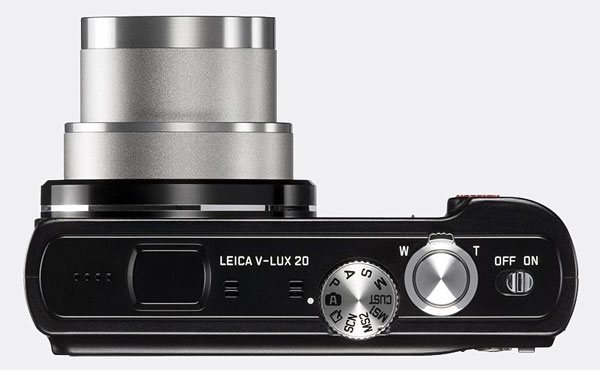New: LEICA V-LUX 20
The universal compact camera for outstanding pictures – from wide to telephoto
 Solms, Germany (April 20, 2010) – Leica Camera AG presents a new, 12.1 megapixel digital compact camera: the LEICA V-LUX 20. Equipped with a high performance DC-VARIO ELMAR lens, innovative GPS tagging, optional HD movie recording and various automated functions, the V-LUX 20 is a truly universal camera, capable of capturing all moments of life.
Solms, Germany (April 20, 2010) – Leica Camera AG presents a new, 12.1 megapixel digital compact camera: the LEICA V-LUX 20. Equipped with a high performance DC-VARIO ELMAR lens, innovative GPS tagging, optional HD movie recording and various automated functions, the V-LUX 20 is a truly universal camera, capable of capturing all moments of life.
The V-LUX 20’s LEICA DC-VARIO-ELMAR 4.1–49.2 mm f/3.3–4.9 ASPH. zoom lens offers a range of focal lengths of 25–300 mm in 35-mm format, making it the ideal camera for almost any photographic environment. Whether shooting expansive landscapes, finely detailed macro studies at short distances or shots of distant objects with a super-telephoto setting, its 12x zoom captures them all in images of breathtaking quality. Integrated image stabilization helps photographers in every shooting situation and also prevents fuzzy pictures caused by camera shake or difficult lighting conditions.
“High-performance optics, compact size and simple, intuitive handling: these are the trademarks of the V-LUX 20. It is the ideal tool for effortless photography and can be utilized by the whole family – for everyday shooting, special occasions or when traveling,” says Peter Kruschewski, Product Manager Digital Compact Cameras at Leica Camera AG. “At the same time, the manual setting options of the V-LUX 20 offer more ambitious photographers absolute creative control over their pictures.”
The LEICA V-LUX 20 is characterized by clear lines, ergonomic design and evidently positioned controls. Its straightforward handling is further enhanced by a whole range of automatic functions. For the more knowledgeable photographer, manual setting options for shutter speed and aperture provide all the creative freedom necessary for image control. A selector dial on the top deck of the camera allows fast and simple selection of a wide range of settings.
The generously dimensioned, three-inch monitor of the V-LUX 20 has a large 3 inch TFT display with a resolution of 460,000 pixels, offering an extremely bright and sharp view. It is a reliable and precise tool for the assessment of image composition and framing before shooting, as well as for quality control of captured shots.
As the first Leica digital camera to feature GPS tagging, the Leica V-LUX 20 allows photographers to record not only the geographical coordinates of the location in the Exif data of the image files, but also the local time for every shot. An extremely useful aid for archiving pictures, the GPS tagging function prevents all travelers from ever forgetting where their pictures were taken. All images posted on social networks, image portals and map sites such as Google Maps or Google Earth reveal exactly when and where they were shot.* When abroad, the V-LUX 20 can also display local sights and interesting places. This feature offers a total of 500,000 so-called ‘points of interest’ in 73 different countries.
In addition to featuring GPS tagging, the V-LUX 20 is equipped with a movie function that enables the recording of moving pictures in HD quality. Together with the camera’s zoom function, smart automatic features such as face recognition, automatic scene modes and smart exposure are all available in movie mode, making the V-LUX 20 a superior movie-maker in a compact format.
The LEICA V-LUX 20 will be available at specialized Leica dealers from the end of April 2010. Adobe Photoshop Elements 8 is one of the standard features provided with V-LUX 20. A matching brown calfskin case for the camera is available as an optional accessory.
For additional information, please visit us.leica-camera.com.
* It is possible that GPS tagging may not function in the People’s Republic of China and neighbouring regions. Satellite signal reception may be impossible, depending on the location. In such cases, the positioning data may be recorded inaccurately or not at all.
About Leica Camera:
Leica represents a union of craftsmanship, technology and experience. It is at once an extension of art, knowledge and philosophy, providing a state-of-the-art optical experience in a precision, hand-made photographic instrument. Leica Camera has a simple mission: to provide users with an incomparable experience, an instrument that defines an unsurpassed heritage and sets a standard of excellence for the industry to meet.
Related Content:
All Leica Camera User Reviews
All Digital Camera User Reviews
Digital Cameras Forum
Leica News & Articles
Leica V-Lux 20 Specs
Leica Web Site





I think it’s important to point out that the Leica V-Lux 20 is Leica’s version of the Panasonic Lumix ZS7 pocket superzoom digital camera that was announced this January. The question with Leica’s compact cameras is always how different they are then the Panasonic version and whether it’s worth the extra dough for the red dot. The Leica models always look a little better but when you check the specs they don’t appear to be much different from what Panasonic offers. However, there is an important difference that is not at all obvious. At least that was the case with the Panasonic LX3 and Leica D-Lux 4. The camera body, controls and basic specs may be the same, but Leica has their own JPEG processing. It’s been a while since I’ve done a back-to-back comparison with a Leica and Panasonic. But when I did, the difference in JPEG image quality was dramatic. The Leica files were much larger, indicating far less compression; and Leica claims to be doing their own processing for better color and contrast.
I think Panasonic is making some of the best point-and-shoot cameras available right now – especially the ZS7. But I’m not a fan of their JPEG processing – not at all. So I am inclined to bet on the Leica V-Lux 20 as a better value for serious photographers who really care about image quality. The Panasonic Lumix ZS7 lists for US $399.95. I would expect the Leica V-Lux 20 to sell for $50 to $100 more.
Does the Leica V-Lux 20 have a view finder. It appears to have one when viewed from the front, but from the back view I can’t tell
Dear Photo John, You think the Leica version of the Panasonic clone is $50 to $100 more? Where have you been? Try double – or more. Just like the D-Lux 4 ($800) vs. LX3 ($400); The V-Lux 20 is $699 and the ZS7 is $314. The V-Lux 20 also does not do the newer, better AVCHD video…. This is an easy choice. I’ve seen all the Leica / Panny face offs – its the same camera.
Here’s the bottom line of the Lecia/Lumix argument: you can drive a Mercedes Benz SL 55AMG or you can drive a Toyota Corolla, YOUR CHOICE. It’s a matter of how much you want to spend, just like everything else in life, you get what you pay for – and you pay for the best. This is an easy choice, V-Lux 20 please.
Devgroup-
While your comparison makes me smile, it’s neither accurate nor fair. The Leica is pretty much a restyled Panasonic. Based on past experience, the JPEG processing in the Leica should be better. But a Mercedes 55 AMG isn’t anything like a Toyota Corolla and I think that comparison is actually irresponsible. You’ll make people believe that they’ll be getting a far superior camera with the Leica and that’s just not true. A more accurate comparison would be Toyota / Lexus – more or less the same car with fancier dressing and maybe a bit more horsepower.
I’ve read that while Panasonic’s lenses are manufactured under license in Japan, Leica cameras are equipped with made-in-Germany ones. How true is it ? Thanks.
I got my v-lux 20 two weeks ago because of the “photo” but not the “spec”. Although it appears that the spec of ZS7 and v-lux 20 are the same in all respect, I found the photos are different. I like the v-lux 20 colour which is “real and natural”. I used to have my Nikon SLR, GF-1 micro 4/3, Pentax and Canon DC to shoot but never get photos of such “natural colour and contrast” as those produced by v-lux 20. We are not mechanists. We are photographers. We should compare the photo but not the cameras. I am of no regret in picking up my v-lux 20, not because of the red-dot but the “photo” it produces.
I need a word of advice, V-Lux 20 vs D-Lux? Normally, one always goes with the newer option. But sometimes things get lost along the way. Which one would it be?
cboym — I think you have to look at the features. The D-Lux 4 has a zoom range of 24-60mm, while the V-Lux 20 has a zoom range of 25-300mm. This is what made the difference for me. I bought the V-Lux 20 in June and have been very happy with it. Also, the D-Lux 4 has no built-in flash, but it does have a hotshoe. The V-Lux 20 does have a built-in flash (but with limited range, of course), but no hotshoe. I hope this helps.
As a ex pro photographer who used to shoot on 6×7 and 35mm film, I find these debates about camera models very amusing, I used to use a 15 year old Nikon FM, and Mamiya RZ: that was it, was never interested in upgrading every couple of years due to the fact that i was selling my work, and it was technically OK. I just don’t understand the current obsession with brands, it’s the end result that counts. Anyway, the standard of photography generally is very low at the moment, compared with past decades.
To Devgroup, who derives a mercedes? the same guy that is wearing a Rolex and wears Tommy Hilfiger? None of them being fashionable by the way. It is almost all the same camera besides the jpeg processing being better with the Leica and the video being better in the Panasonic. And go buy your Mercedes, one of the last disgraceful German brands.
And I want to clarify, I am not downplaying the quality of a Leica as for I draw no comparison between Leica and Mercedes. The insult was directed entirely towards Mercedes Benz. Leica Cameras are great products.
From the research I have done there are a few notable differences between the Leica and Panasonic. Leica = 3 year international warranty, Panny = 1 year domestic; Leica does 720p @60fps, Panny does 720p @30fps using AVHCD Lite which will make the files smaller; IQ is better with the Leica; Panny has noticeable blown highlights issue which will not show detail on bright white areas such as the sky or a white blouse with a pattern (the pattern will not be visible). It was this last issue that sold me on the Leica.
I HAVE A QUESTION.
I HAVE LEICA V-LUX 20. WILL I BE ABLE TO USE THE BOOK FOR D-LUX 4? ARE THESE 2 MODELS VERY DIFFERENT OR NOT?
I have the strangest finding when taking a photo with the new leica V-Lux 20 – I captured a supernatural image – I know some may think this is crazy, but I captured a shadow of a child clearly visible on the background. I showed the picture to may persons without telling them about the child, and every one without hesitating was asking me: Who is that child in the background? Can anyone help in this? If this is the case, maybe we call the brothers Kling of Discovery to investigate the use of Leica as a supernatural detector.
PS – I am NOT making this up, and definitely I am not a believer in supernatural things.
Bob
Any thoughts on Leica vs Lumix DMC LX5??? I note that the Leica comes with Adobe Photo Elements 8 which is a AUD$130 software .. . if I had read this before buying the Lumix, I would have bought the Leica.